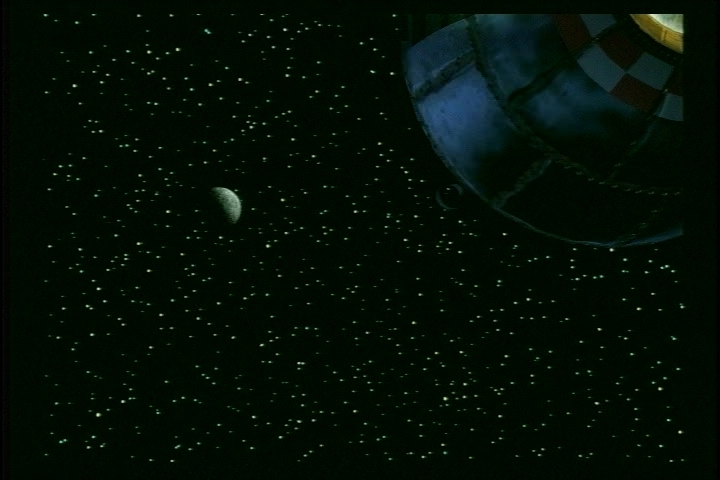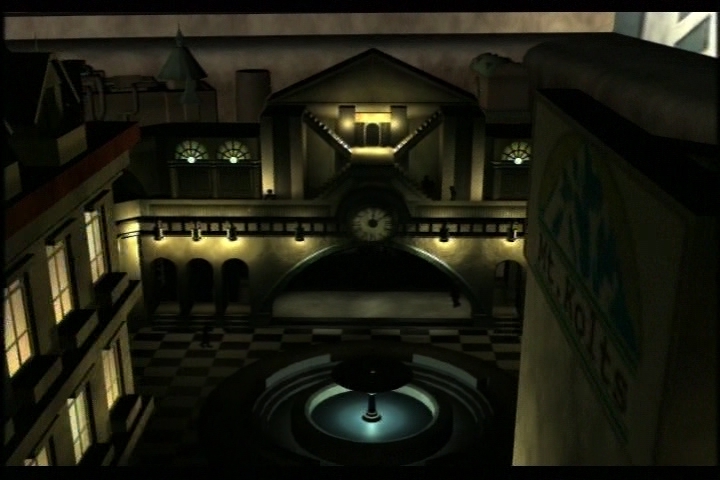PlayStation versus Toshiba DVD: FMV Analysis
Much like when Eidos received an old, buggy version of FFVII (one that pre-dates the first official release) when they first began making the PC port, so did Toshiba receive old FMV files when they made the FFVII CG Collection DVD. This article will thoroughly go through those FMVs on the DVD that show differences with those of the final game. Miscellaneous observations shall be made along the way as well.
Before that, let’s summarize the differences in performance between the PS and DVD FMVs:
– Toshiba’s versions have a higher saturation coupled with a stronger green tone. The exact conversion procedures may have been different, but a superficial comparison between the two makes me draw this conclusion.
– Due to the shift towards a stonger green tone, other color changes can be spotted, such as the Junon airport appearing more yellow.
– PS FMVs play at 320×224 resolution while most DVD FMVs play at 640×448 (when the black walls are removed). The opening FMV is the only exception with its 717×456 resolution.
– The color of the PS FMVs are probably closer to the original, as seen, for example, by Cloud’s pants being appropriately purple in the PS rendition versus more blue in the DVD file.
– Each frame in the PlayStation FMVs contained the ghost of its previous frame as a result of poor conversion. The Toshiba files show no ghosting.
Article Guide:
– While the DVD does in fact play at 30 frames per second, no new intermediate frames are seen that can’t already be spotted in the PS FMVs. For this reason, I shall treat the DVD versions as though they were 15 fps, so if I say that one frame is missing in a video then I mean that 1/15 seconds (≈66.67 milliseconds) are missing.
– Videos are spread throughout this article showing the PS and DVD renditions side by side. Due to an error in the video editor, the DVD FMVs become compressed in comparison to the PS FMVs. Ignore this error in the comparison videos.
Content Index:
– Comparisons: FMV Montage
– Comparisons: Titled Clips
– Miscellaneous
– Credits & Sources
Comparisons: FMV Montage
We begin by exploring the FMVs seen exclusively in the montage sequence. All of these are incomplete to a varying degree. The file names in brackets are the FMV names as read in the files of the PlayStation game.
Reactor Bridge Explosion (SMK)
Click to watch SMK comparison video
The camera is positioned higher in the old version. This means that some parts of the lightning effects at the top are only seen in the DVD, while the effects at the very bottom of the PS rendition are not seen in the DVD fragment.
Makonoid Breaking Free (NVLMK)
Click to watch NVLMK comparison video
Originally, this sequence lacked the lightning effects around the mako pod.
Meteor Reveal in Junon (METEOSKY)
Click to watch METEOSKY comparison video
The DVD shows more empty sky patches and has a different set of cloud formations. The DVD’s enhanced green tone might be solely to blame for the clouds’ lack of redness. It is also possible that the red tone was increased later on as a way to enforce the sense of doom that Meteor is meant to be associated with.
Notice that a specific part of the cloud formation is used for both the PS and DVD sequence. The lower left part is used in both, except they are mirrored to one another.
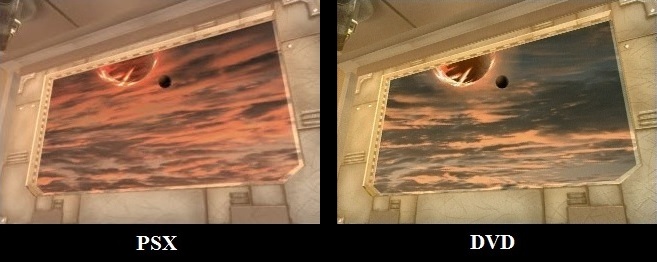
The PS version of meteosky has a final shot, outside of Junon, that we don’t get to see in the FMV montage. The aforementioned cloud formation reappears here. It also briefly appears again in a shot from the weapon0 FMV (right snapshot below), both in the PS file and on the DVD.
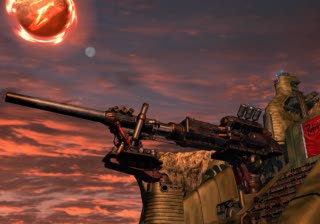

A person obsessed with detail can spot how these sky backgrounds match to varying degrees.
Gelnika-Type Airship Takes Off (GELNICA)
Click to watch GELNICA comparison video
In both the FFVII Toshiba DVD and the Collector’s Video VHS, this old version of the Gelnika sequence be spotted. Here the Gelnika-type airship takes off from the airport without any descent at all. The final rendition adds a sense of gravity by having the airship briefly descend after going over the edge, then slowly gain height as it flies off into the distance.
Comparisons: Titled Clips
Now we move on to commenting on the FMVs found in the CG CLIP section. Here each sequence is preceded by a title card that shows the FMV’s name, a date (meaning unknown) and the number of frames the video consists of. There are some differences to spot between the FMV names here compared with their file names in the PS versions.
| DVD | PS |
| goldsaucer1 | GOLD1 |
| goldsaucer2 | GOLD2 |
| goldsaucer3 | GOLD3 |
| goldsaucer4 | GOLD4 |
| goldsaucer5B | GOLD5 |
| goldsaucer7 | GOLD7 & GOLD7_2 |
| canonfire | CANON |
| rckthit | RCKTHIT & RCKTHIT2 |
| bike | (PS) BIKEGET, (PC) bike |
Another small difference to point out before resuming the meat of this commentary is that some titled sequences lack single frames.
PHOENIX: DVD lacks the first frame.
CANONFIRE (CANON in PS): DVD lacks one frame at the end.
CANONON: DVD has one extra frame at the beginning.
Junon Prepares for Sapphire Weapon (weapon0)
Click to watch weapon0 comparison video
The final shot reveals two differences; one immediately obvious and one that can easily be overlooked.
For the PS file, the sky was changed to be red even where there seemingly are no clouds. The effect of the sky moving as the camera does is immensely exaggerated in the last shot from the older version of the FMV. In the final version, the red sky is almost completely still.
The airport shows the blurry presence of an arship in the PS rendition, but this is completely missing in the DVD version. The ship seems to have a rather brownish-red tone, and it is difficult to infer whether this is meant to be a Gelnika-type airship.
Gold Saucer, Balloons Rising (goldsaucer5B)
Click to watch goldsaucer5B comparison video
The DVD version lingers one second longer on the first shot of the ascending balloons before transitioning to the gondola.
Interrupted by Fireworks (goldsaucer7)
Click to watch goldsaucer7 comparison video
What the FFVII Toshiba DVD dubs as one single sequence, goldsaucer7, was divided in two, GOLD7 & GOLD7_2, for the final game. In the process, a middle segment was deleted that shows the camera panning back and displaying the interior of the gondola. This unused transition places the gondola even further away from the Gold Saucer than any of the previous establishing shots.
It is, in fact, possible to spot this unused shot in the final game by ripping the very first frame from GOLD7_2. Due to the ghosting effect in the PS FMVs, the previous frame lingers here, hence why we can spot the gondola interior.

The reason for the split was to allow a full (normal) scene to play out where Cloud’s date is allowed a monologue before the next firework FMV starts.
Fall of Sector 7 (fallpl)
Click to watch fallpl comparison video
The older version shows a change in President Shinra’s eye brow texture that is not present in the final game: His eye brow widens, presumably meant as a hint of a sinister expression.
However, the shot stays longer on Shinra senior in the PS version, perhaps as an adaptation made to lengthen the moment when we hear Haydn’s composition “The Creation”.
The DVD sequence ends slightly earlier; roughly when the final version begins fading out.
The room seen at 0:14-0:17 is, in fact, the left segment of ONNA_6, one of the unused Honey Bee Inn rooms. In the same room, we see a television broadcast of what might be a news reading. Next to him is an unidentified icon that not even the DVD FMV is crisp enough to shed any light on. To me it looks like a yellow-shirted football player, but it could admittedly be almost anything.

Capsule Ejected & Rocket Crashing into Meteor (rckthit)
Like goldsaucer7 was divided into GOLD7 and GOLD7_2, rckthit was divided into RCKTHIT and RCKTHIT2. This allowed a scene inside the rocket capsule to play itself out after RCKTHIT, but before the capsule falls down to the planet in RCKTHIT2. This time, only one FMV frame was lost in the cutting process. Below is the one frame we don’t get to see in the final game.
Sephiroth in Fire (nivlsfs)
Click to watch nivlsfs comparison video
Rather than phasing through the fire like in the final game, the DVD sequence has Sephiroth being engulfed by the fire and disappearing about one second earlier. The fire effects were also changed to some degree, as we see that all the fire fades out at once in the old version, while the front layer of the fire stays visible longer than the back layer in the final version.
The FFVII International Bonus Disc uses the older version with Sephiroth being engulfed by the fire and it can be accessed by going to Nibelheim via the World Map and then clicking on the movie reel icon. Due to poor practices when making the Bonus Disc, all the FMVs are in even lower quality here than those of the main game.


Sephiroth meets Jenova (nivljnv)
Click to watch nivljnv comparison video
The DVD delivers us with a “clean” version of Sephiroth’s meeting with Jenova by not including his monologue imposed over the FMV. The monologue can also be found as unused text in the preceding in-game field (see Unused Text Part 5, Page 2). Whether it was a later decision to hard-code Sephiroth’s script into the FMV we can only speculate.
The other primary difference is Sephiroth’s eye texture in the up-close shot right before he tears away the angelic statue. There is more eye shadow in the DVD version, which matches perfectly with both the preceding and final face shots.
Thus, we see that the eye texture used in the final game at this moment does not match with the previously mentioned face shots.
The eye texture used in the scene’s very first angle does not seem to match up with anything else in this FMV.
The FMV is called NIVLJNV in the DVD and in both Japanese game releases, but was renamed “JENOVA_E” for the English release due to the change from a Japanese to an English monologue.
Though the writing on Jenova’s helmet has been repeatedly confirmed via other sources, it is worth nothing that the high-quality DVD rendition allows us to read the inscriptions.
“JENOVA
MADE IN HONG KONG
ALL RIGHTS RESERVED 1996
SQUER COMPANY LIMITED”
We spot the contours of more writings on each side of the wall, but they are altogether illegible.
Escape from Shinra HQ (bike)
Out of all the FMVs analysed in this article, this is the one most rife with differences.
Click to watch bike comparison video
First of all, the sequence is shorter in the DVD, as it does not include the intro section with Cloud driving along the stairs and the rest of AVALANCHE stealing the truck. Instead, it begins by showing Cloud driving toward the window, and, in fact, shows 11 more frames of this segment, so the PS rendition catches up later.
Second, the DVD lingers longer on Cloud’s midair arc, and completely lacks the transition to the shot with the Shinra grunt and the spotlights. For the older and final versions of the scene to match up after this when played next to each other, only one blank frame needs to be added to the PS version (hence the single black frame in the video).
Third, there were originally no sparks when the Hardy Daytona bike lands on the pavement. We also see that the gas spewing from the exhaust pipes is something that was added later, as was showing that the pipes are, indeed, open for exhaust to escape.
Fourth, the camera moves down the road for 16 additional frames in the DVD before finally cutting off.
It is possible to spot in both versions that as soon as they leave Shinra HQ not just Cloud, but Barret and Red XIII also lack facial textures. You may also notice that Barret’s CG model becomes much more primitive when we see him on the highway compared to his more advanced CG model in the earlier part of the FMV. All things considered, it looks more and more like the second half of the FMV predates the first half (which, again, is not seen in the DVD).
This older bike sequence is also shown in the Collector’s Video VHS.
Miscellaneous
Opening FMV
Click to watch Opening FMV upload
This FMV differs from the rest of what the DVD has to offer because sound effects are actually included here. Oddly enough, only the sound of Aerith’s footsteps are missing. This does not appear to align with any changes that happened during production though; even the FMV intro played in the earliest FFVII demo (released in June 1996) includes the footsteps.
This FMV also has very thin black borders in comparison to the rest in the list. It makes you wonder yet again why the FMVs were compressed in width and given black borders.
The star-swipe is skipped and the video fades into white before the train makes a full stop.
When the camera shifts from Aerith’s face to her side, the PS movie spends ONE MORE FRAME on her face than the DVD does. A very tiny, odd difference.
The text “©1997 SQUARE” appears in a slightly different font when comparing the PS and DVD versions.

|
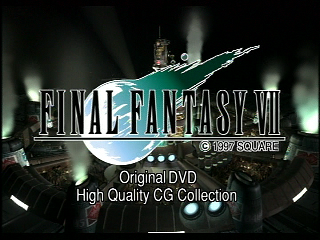
|
Let us analyse two details in a snapshot from the early segment of the DVD opening. The first one is impossible to spot in PS. The second one is simply made easier thanks to the DVD, but can be figured out via the PlayStation FMV also.
1) “MM” is written in the background. There is possibly text both above and below MM, but it is unreadable. Does MM stand for anything? Could it be a signature? The only person among the FFVII staff (as listed in the game’s ending credits) with these initials would be Makiko Mizushima, who is listed as a member of the Links Corporation, one of the “CG Outside Contractors”. Admittedly, that Makiko Mizushima would have placed his initials in the opening FMV sounds very farfetched.
2) A poster with a symbol and some unreadable text below it. The symbol can actually be recognized via some of the game’s fields, except the symbol is mirrored in relation to the FMV version of the poster. These are the fields MD8_2, MD8_3 and MD8_6 respectively.



The symbol appears to be a dish of some kind, but I can’t tell for sure. It is also seen in MD8_32, although that field is simply an adaptation of MD8_3.
MD8_3 and MD8_32 also include the “Mt. Kolts” poster, which is a reference to a mountain area in FFVI. This poster can be spotted in the intro FMV in both the PS and DVD presentations, but it is much easier to read in the latter due to the lack of ghosting.
The Mt. Kolts reference is seen again in the MD8_5 field.
The symbols and boards of goldsaucer1
Click to watch goldsaucer1 upload
The final shot of the first Gold Saucer FMV is rife with symbols and signs. Many can be made out in the PS file, but with the benefit of snapshots at DVD quality, we can analyse each sign more closely.
We shall look at the pictures to the left side of the entrance first, then those to the right side. Match the numbers in the image with the descriptions in the list. Often, the text can only be made out by watching the video in motion and analysing multiple snapshots.

L1: A circle with an unknown symbol (possibly a kanji) within, followed by the number “300”.
L2: An oddly colored face with a purple “thing” to its right.
L3: ???
L4: Skull with two bones crossed behind it. This might represent the Battle Square, as a skull can be spotted above the entrance to the battle arena. The latter image lacks any crossed bones, however.
L5: The text “Chocobo RACE” with a very cartoony chocobo next to it.
L6: A prohibited sign? Might be a “no smoking” sign, but it’s impossible to confirm.
L7: JET represents the Speed Square. The first Speed Square area is called “JET” in the game files, while the area where you pay for the roller coaster ride is called “JETIN1“. This is because, in Japanese, roller coasters are more commonly referred to as “jet coasters”.
L8: Advertisement for the Ghost Hotel. The word “hotel” is never shown here, though.
L9: “Enjoy” written three times in different colors.
L10: ???
L11: “COMBAT BEGIN”. What game is this from?
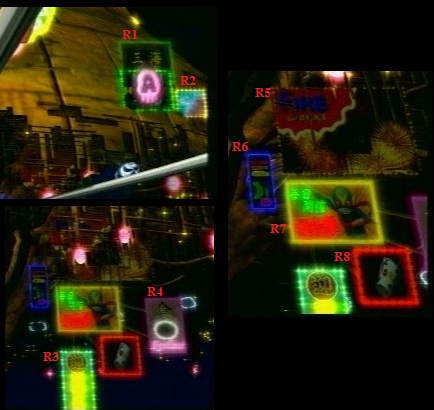
R1: Weird pink thing with an A on it. A small, oddly shaped H is written to the left. The kanji at the top appear to be 三海 (‘three seas’). What is that relevant to?
R2: The resolution is, in fact, too low, but I have one guess: a flying saucer next to the left portion of golden square.
R3: The kanji for ???.
R4: Indiscernable symbols and text. Increasing the contrast and lowering the brightness can make it look like you are reading greek letters/symbols, but the quality is not enough to be certain.
R5: The text “FIRE WORKS”, appropriately coupled with fireworks on the board.
R6: Colors and shapes that may or may not relate to anything.
R7: The figure is reminiscent of characters like the Japanese superhero “Kamen Rider”. The upper right kanji seems to be 日 (‘day’).
R8: Appears to be official art for some armor or accessory in the game, but after browsing the Final Fantasy VII Ultimania Omega, I have found nothing that looks like this. Could it be a cup?
Thank you for reading this article. To find download links to all the FMVs of the Toshiba FFVII DVD, as well as the PerfectTV Making of FFVII feature, scroll to the bottom of the page in the FFVII Toshiba DVD Review article.
You may also watch all the clips in succession in this YouTube playlist.
CREDITS
Thanks to TLS member Squall_of_SeeD for proofreading and correcting this article.
TOOLS
– PlayStation FMVs were ripped from the game using jPSXdec.
– Comparison videos made and uploaded using Vegas Pro.
Discuss this DVD on our forums!


